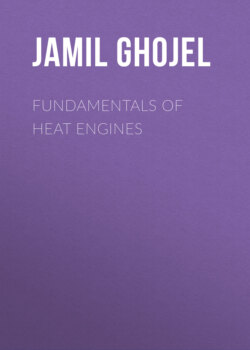Читать книгу Fundamentals of Heat Engines - Jamil Ghojel - Страница 31
1.2.2 Fluid Flow
ОглавлениеIf a fluid body with cross‐sectional area A is flowing at velocity C, its volumetric flow rate Q is given by
(1.25)
And the mass flow rate is given by
(1.26)
Consider now the flow of this fluid through the control volume shown in Figure 1.6. The mass flow equations at inlet 1 and exit 2 are given by
Figure 1.6 Fluid flow through a control volume.
The continuity equation or equation of conservation of mass for this flow is obtained by equating the mass flow rates at sections 1 and 2, , or
(1.27)
The total energy (in units of N. m) for an element of fluid of mass m at sections 1 and 2 of the control volume shown in Figure 1.6 is given by
where
mp/ρ : flow energy required to move fluid element m against pressure p
mC2/2 : kinetic energy of element m travelling at velocity C
mgz : potential energy of the element due to its elevation z relative to a reference level
If there is no energy addition, storage, or loss between sections 1 and 2, the energy will be conserved, and E1 = E2:
(1.28)
or, in terms of pressure heads (in metres, for example)
(1.29)
If both sides of Eq. (1.28) are multiplied by ρ, it can be rewritten in terms of fluid pressure as
(1.30)
Equation (1.30) is known as Bernoulli's equation. If it is rewritten in differential form, it gives Euler's equation:
(1.31)
